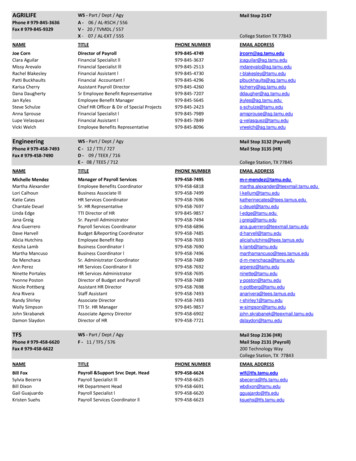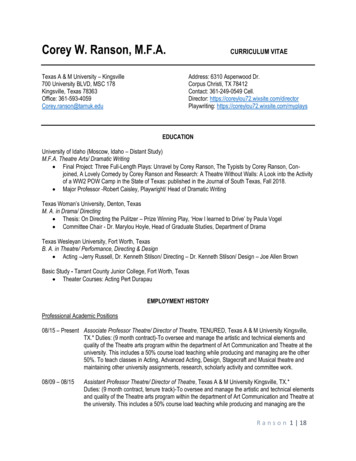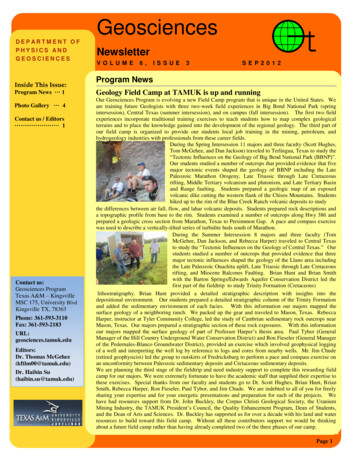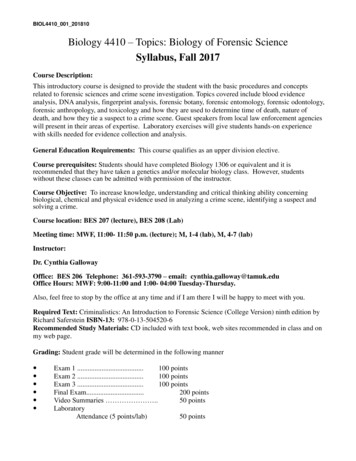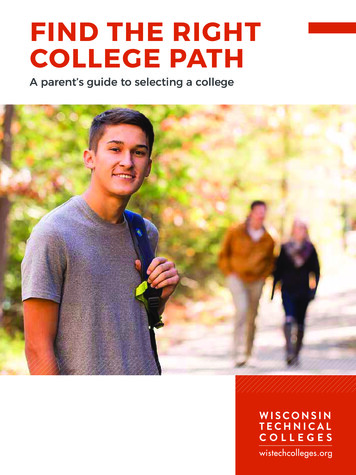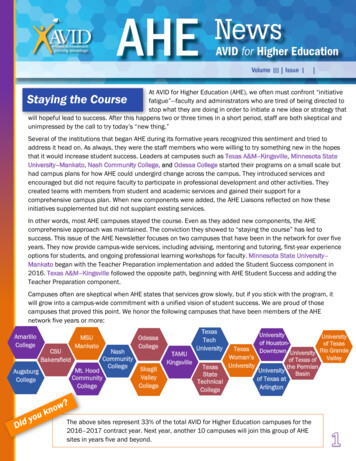
Transcription
IIIIAt AVID for Higher Education (AHE), we often must confront “initiativefatigue”—faculty and administrators who are tired of being directed tostop what they are doing in order to initiate a new idea or strategy thatwill hopeful lead to success. After this happens two or three times in a short period, staff are both skeptical andunimpressed by the call to try today’s “new thing.”Staying the CourseSeveral of the institutions that began AHE during its formative years recognized this sentiment and tried toaddress it head on. As always, they were the staff members who were willing to try something new in the hopesthat it would increase student success. Leaders at campuses such as Texas A&M–Kingsville, Minnesota StateUniversity–Mankato, Nash Community College, and Odessa College started their programs on a small scale buthad campus plans for how AHE could undergird change across the campus. They introduced services andencouraged but did not require faculty to participate in professional development and other activities. Theycreated teams with members from student and academic services and gained their support for acomprehensive campus plan. When new components were added, the AHE Liaisons reflected on how theseinitiatives supplemented but did not supplant existing services.In other words, most AHE campuses stayed the course. Even as they added new components, the AHEcomprehensive approach was maintained. The conviction they showed to “staying the course” has led tosuccess. This issue of the AHE Newsletter focuses on two campuses that have been in the network for over fiveyears. They now provide campus-wide services, including advising, mentoring and tutoring, first-year experienceoptions for students, and ongoing professional learning workshops for faculty. Minnesota State University–Mankato began with the Teacher Preparation implementation and added the Student Success component in2016. Texas A&M–Kingsville followed the opposite path, beginning with AHE Student Success and adding theTeacher Preparation component.Campuses often are skeptical when AHE states that services grow slowly, but if you stick with the program, itwill grow into a campus-wide commitment with a unified vision of student success. We are proud of thosecampuses that proved this point. We honor the following campuses that have been members of the AHEnetwork five years or SUMankatoMt. yUniversityof Houstonof TexasTexasDowntown University Rio GrandeTAMUWoman’sValleyof Texas ofKingsvilleUniversitythe PermianTexasUniversityBasinStateof Texas atTechnicalArlingtonCollegeThe above sites represent 33% of the total AVID for Higher Education campuses for the2016–2017 contract year. Next year, another 10 campuses will join this group of AHEsites in years five and beyond.
TAMUK Expands Professional DevelopmentIn 2010, Texas A&M University–Kingsville (TAMUK) became one of the first campuses to join AHE. From thebeginning, they incorporated the services provided into their newly created Center for Student Success. The purposeof the center was, according to Stephanie Bain De Los Santos, AHE Liaison, “to build a circle of care for our studentsthat creates a sense of community and family even if they are far from home or have no other support.” The Centerwould measure its progress by increases in the retention rate, which stood at 55% in 2011. Over time, TAMUKdeveloped and refined all of the components of AHE, beginning with the Center itself, which serves as a gatheringplace for both students and faculty. They also created a two-semester first-year-experience course, began a vibrantpeer tutoring/mentoring program, offered supplemental instruction, and centralized professional academic advising.These student services are enhanced by a common read program and an author lecture series.But all of these components depend on the commitment and expertise of faculty who are dedicated to studentsuccess. The Center for Student Success also partners with the Center for Teaching Effectiveness to provide anongoing professional development program that is required of new faculty but open to all. In 2016–17, the programenrolled an average of 36 tenured faculty members in its workshops. These sessions frequently are led by AHEconsultants and staff who have built a collegial relationship with TAMUK faculty and administration. Upon completionof the training sequence, faculty members receive an AVID certificate for documentation in their annual report.Stephanie Bain De Los Santos adds, “We are so excited to be able to offer thisopportunity to our faculty and staff. At the end of the day it is the students thatbenefit from all of the hard work that we put in.” TAMUK’s faculty developmentseries not only engages its faculty but also extends invitations to local schooldistricts, inviting them to join the workshop sessions. These K–12 educators alsoreceive a TAMUK AVID certificate that they can use as CTE hours towards their stateprofessional development requirement. TAMUK also participates in the TeacherPreparation components of AHE and works with local districts to assure that theyhave new teachers who are ready to provide AVID high-impact practices at everyStephanie De Los Santos,grade level.AHE Liaison/Common ReadOn the AHE Teacher Preparation side, the Center averages 80 attendees includingCoordinator, TAMUKfaculty members, student teachers, and cooperating teachers from the localdistricts. TAMUK’s Teacher Preparation partnered with Premont ISD in Premont, Texas. The district was indanger of closure when the accountability rating of Premont ISD for 2013 was Improvement Required; however,in 2014 it was Accredited–Warned, in 2015 it was Accredited–Probation, and in 2016 it met requiredstandards. Since the implementation of AHE Teacher Preparation, the number of student teachers being offeredjobs at the end of their student teaching has increased. In addition, the use of AVID strategies complementsand provides evidence of student engagement for the newly adopted TAP teacher evaluation rubric used toevaluate field and student teachers. The modeling of AVID strategies embedded within TAMUK’s educationclasses as a means to teach course content helps education students realize the potential of the AVIDstrategies as invaluable resources for their future classrooms.Student success programs as extensive and comprehensive as TAMUK’s are not successful by chance. Thecampus has been fortunate to have leadership support and continuity from the beginning. Dr. NancyKingSanders, Associate Vice President for Student Success, has overseen the development of AHE, serving asits campus liaison since 2011. She continues to work with a team that manages the Center for StudentSuccess. TAMUK also relies on AHE coaching to provide both advice and support and to provide the facultydevelopment workshops that serve as the foundation of TAMUK’s comprehensive student success program.Experience and commitment make a difference at TAMUK and have led to success. In 2016, the university’sFirst Time in College retention rate is 71%, marking an increase of 17% since the Center’s opening just six yearsago. According to Nancy KingSanders, “AVID for Higher Education has provided the foundation for students tobe successful in their first year through graduation, as all mentors, tutors, first-year seminar faculty, and manyother faculty use AVID high-impact strategies to ensure that students feel (continued on page 3)
(continued from page 2) empowered to learn.” For more information on the Center for Student Success atTAMUK, please contact: Christina Rodriguez-Gonzales, Director of GPS Mentoring & PAAC Tutoring Centers, at christina.rodriguezgonzalez@tamuk.eduJeanine Birdwell, Lecturer/Assistant Director of Mentoring & Tutoring, at barbara.birdwell@tamuk.eduBret Vanness, First-Year Seminar Coordinator, at bret.vanness@tamuk.eduStephanie Bain De Los Santos, AHE Liaison/Common Read Coordinator, atstephanie.delossantos@tamuk.eduTeacher Prep At MSU–MankatoSupports Local Districts“Prepare professionals who embrace bigideas and real-world thinking to ensurestudent )True to their mission statement, Minnesota State University–Mankato and its partner school districts havebuilt, refined, and reflected upon their work as they’ve moved into their sixth year of AVID for HigherEducation implementation. This partnership with AHE’s Teacher Preparation implementation is allowing theUniversity’s College of Education and their partner K–12 school districts to move beyond a partnership to atrue system for teacher preparation and student learning. They have used the AVID Socratic Tutorial as asystem within a system to explore ways that they are linked together. Andy Krause from Mankato East HighSchool and Laura Bemel, Director of the Center for Educator Partnerships and Student Support at MinnesotaState University–Mankato, have worked successfully together to develop a model utilizing AVID. Laura hasnoted several intricate components that have truly and systematically worked together to enact changes inhow AVID has been leveraged to make a difference for students, both at the secondary and postsecondarylevels. Based on the following principles, the partnership between the university and the school districts hasbeen enhanced.1.The parts of the system work together for a common purpose. Our teacher candidates are studyinglearning theory and best practices for teaching students. They get to have wonderful field experiencesas tutors in the AVID classrooms, where they are constantly using their AVID strategies to betterunderstand student thinking and to create helpful questions for kids. The AVID teachers observe theuniversity students during their tutorials and provide feedback and pose questions that prompt thesefuture teachers to think about their AVID students and their own teaching practice. We’re seeingsuccess for students and for AVID tutors.2.The system functions best when all the parts are in the right place. We realized that our basic triad oftutor-student-teacher is essential, but we haven’t always connected the other parts of the system sothey can contribute or see the benefit. Now our university faculty are modeling and using more AVIDstrategies earlier in their Education courses, and they are visiting AVID tutorial sites. We are proudthat our numbers of tutors are growing and that faculty are asking about what’s going on.3.When one part of the system changes, the other parts might need to adapt to keep functioning. As ourteacher candidates get better at asking questions and eliciting student thinking because of their workas AVID tutors, faculty members are noticing this improvement in their university courses. Facultyhave come to expect higher-level questioning from these teacher candidates in their other fieldwork.Faculty are asking questions about what students are learning because of the AVID experience. Whileit’s ideal to have all parts working optimally, the system still works if some of the parts becomeinactive or fail.Most recently, both Laura and Andy co-presented at AVID’s National Conference in December 2016. In theirsession, “Better Together! How K–12 and University AVID Benefit from a Systems Approach,” they highlightedthe work that they are doing with AVID tutors in the school districts who are also teacher candidates atMinnesota State. Both enthusiastically shared how their work is engaging not only for K–12 students and theteacher candidates but also for them as reflective practitioners, in order to determine if the system is workingand to consider how this system will advance student success for young learners and for adult learners whowant to become teachers. In turn, this informs cycles of continuous improvement for this innovative system ofconnecting an institution of higher education and K–12 schools.Article written by Laura Bemel and Rachel Juarez-Torres
NCC’s Commitment Yields ResultsNash Community College (NCC) in Rocky Mt.,North Carolina is another example of howAHE colleges that have stayed the course are realizing continued success. Associate Vice President of Curriculum andChief Program Officer Mike Latham reported the following data in February 2017.“AVID for Higher Education has been a vital part of the success of Nash Community College and its students.Since beginning our partnership with AVID for Higher Education in Fall 2012, Nash Community College has, likethe North Carolina Community College System as a whole, experienced a precipitous decline in new enrollments.In the particular case of Nash Community College, the decline in new enrollments during the period has rangedfrom 10 to 25 percent per semester. However, unlike almost all the other Colleges in the NC system over thattime frame, Nash CC has seen its student headcount and FTE either grow or at least remain flat. This has beendue to increased retention of students, in which AVID strategies in classroom pedagogy played a predominantrole. This has meant hundreds of thousands of dollars in budget funding for Nash Community College. Moreimportantly for our students, over the same period we've seen increases in our number of graduates. During thetime we've implemented AVID strategies and their spread across the campus, the following has occurred:Spring 2013 graduation up 5%;Spring 2014 graduation up 4%;Spring 2015 graduation up 15%;Spring 2016 graduation up 14%.We are trending towards another major increase this Spring (2017). While we have instituted a variety ofinitiatives that have contributed to this, the common factor in all of them has been AVID. Thus, the College'sassociation with AVID for Higher Education has been one of the best investments the College has ever made.”President Gregory Williams of Odessa College in Odessa, Texas usedthe discipline and techniques found in AVID for Higher Education inpursuing his vision to become the best student-focused communitycollege in the nation. Located in West Texas, Odessa College servesa diverse region that historically has had low levels of educationalattainment. Despite its isolation and challenging economicenvironment, Odessa College has developed a culture in whichstudent outcomes—notably, completion and preparation for good,available jobs—drive important decisions, from hiring faculty andstaff to crafting professional development opportunities andsetting budget priorities. This student-centered approach isreflected in an aggressive reform agenda including changes in thecore academic schedule and an overhaul in advising practices.Odessa College was named one of the Top Ten National Finalistsfor the 2017 Aspen Prize for Community College Excellence andwent on to become one of just two Rising Star Finalists fromamong that Top Ten. One impressive outcome recognized by TheAspen Institute is the dramatic increase in graduation/transferrates—from 15% to 32% over a five-year period. OC was alsocommended for the fact that five years after graduating, onaverage, Odessa College students earn more than double thewages of all other workers in the region. AHE is very proud to be acollaborating partner with Odessa College. Dr. Don Wood, OdessaCollege’s Vice President of Institutional Effectiveness, said, “AVIDis a central part of our student's achievements, and on behalf ofOC we look forward to even more student success in the future.”The college partnered with AHE and implemented AHE campus-wide in 2012. In 2013, Odessa College pilotedAHE’s career/technical course workshops that are now shared with other AHE (continued on page 5)
(Continued from page 4) community colleges across the nation. In 2016, Odessa College was recognized asAHE’s first National Demonstration College. They have been a leader in what it means to be “all in” when itcomes to student success. Campus leaders Dr. Kimberly McKay, Vice President for Student Success; Dr. DianeCarrasco, Dean of Teaching and Learning; and Katie Nisbet, Associate Dean of Arts & Sciences, havepartnered with AHE to share their journey at many colleges and conferences.In February, AHE held three AHE Liaisonsmeetings—one for Teacher Preparationnetwork campuses at the AHE Dallas OfficeTraining Room and two for Student Successcampuses—one hosted by Odessa College (TX) and the other hosted by Nash Community College (NC). In all,over 40 people from 26 programs attended the meetings.AHE’s Annual Liaison Meetings:A Must-Attend EventLiaisons meetings are an important part of the administrative support offered to AHE campuses. Regardlessof the number of meeting sites, the agendas are similar to ensure that you receive critical information.Typically, AHE staff provide updates regarding program resources and share an overview of data andevaluation results collected since the last meeting. This year, the hosting campuses highlighted their AHEimplementation, and another AHE campuses provided an in-depth review of successes they haveimplemented. Odessa College opened with a presentation from their President, Dr. Greg Williams, aboutdisrupting systems and processes that hinder student success. Kristi Clemmer and Denise Frohlich, OdessaCollege’s AHE Liaisons, presented the participants with challenging questions that OC had to address alongtheir path to increasing student success and access to careers. At the OdessaLiaisons meeting, Stephanie De Los Santos of Texas A&M–Kingsville providedan overview of its Center for Student Success, which has enriched itsofferings each year since it was created in 2011. Also, Trisha Jenkins fromSaddleback College (CA) shared their Excellence in Teaching Program,highlighting how they are recognizing faculty with an AHE Completiondocument after completion of a series of AHE high-engagement facultydevelopment sessions. This work has increased student retention andsuccess, as indicated in their MSDF Year 2 grant results. Nash CC highlightedits campus implementation—including its Math Lab and how they coordinateAHE Liaisons at the Nash Studentwith their Early College High School, which is on their campus—not just to AHESuccess (above) and AVID CenterDallas Teacher Preparation (below)liaisons but also to nearby North Carolina colleges and local school districts.2017 Liaison Meetings.Joseph Shields from Gibson Consulting shared the MSDF Year 2 Report.Changes in the AHE data collection document were discussed and inputgathered for the final revision that will be discussed in the AHE Liaisonsstrand at the 2017 AVID Summer Institute in San Antonio.The Teacher Preparation Liaisons meeting highlighted the work that Universityof Texas of the Permian Basin College of Education is doing with local schools.A webinar with Amy Anderson, Principal of Hays Elementary School (EctorCounty ISD), shared how the faculty and students have benefited from thecollaboration. The question and answer session mined the relationships andoutcomes that have increased student teacher successes. Teacher Preparation liaisons delved into why “gritand empathy” are critical elements in creating a culture of innovation. The participants then collaborated toform plans for each campus to move forward in implementing innovative practices within their teacherpreparation programs.Finally, liaisons networked with one another, addressing challenges and successes they have experienced thisyear. Sharing with colleagues who have the same professional interests offers the chance to get “on theground” and up-to-date information.Make sure you plan to attend the next liaisons meeting in February 2018.
UTRGV AVID Teacher PrepSince 2005, Excelencia, an organization dedicated to increasing success for Latinostudents, has selected college and university programs that it believes to be models ofwell-researched and well-implemented services that address it mission. In 2016,Excelencia recognized the University of Texas Rio Grande Valley as a model HispanicServing Institution and added it to the Examples of Excelencia’s Growing What Works list of successfulcampuses. The AHE Teacher Preparation program was implemented at The University of Texas—Pan American(now UT Rio Grande Valley) in 2012. AHE Teacher Preparation at UTRGV has been infused with the institution’sUTeach program, which prepares and certifies math and science majors for the field of secondary education.UTRGV was recognized for their excellent work with Hispanic students.Some evidence of effectiveness includes numbers of students, instructors, and mentor teachers trained; examresults; and career placement. A total of 373 students are currently enrolled in the UTeach/AVID TeacherPreparation program, and 98% of them are Hispanic. Since 2015, AVID Teacher Preparation instructionalstrategies were taught to 18 university faculty, 60 local school district mentor teachers, and over 300 UTeachstudents. There have been 60 graduates to date, 97% of whom are Latino, and 100% of graduates havepassed both teacher certification exams required by the state of Texas. Also, 86% of AVID Teacher Prepgraduates are currently employed by school districts, most of which are at a school district in the Rio GrandeValley. There is a greater than 80% retention rate from the beginning of the program to graduation.According to Dr. Karen Watt, “AVID for Higher Education's Teacher Preparation pairs perfectly with the UTeachprogram at UTRGV. Since UTeach students begin their teaching experiences in their first year of college, AHEstrategies that are taught in each class serve to support students in the field from the very beginning of theirprogram. The strategies are especially important for the UTeach students (math and science majors) who arenot exposed to as many pedagogy classes as are the traditional teacher preparation students. Instructors,students, and mentor teachers engage in AVID professional development to enhance UTeach studentexperiences.”AHE congratulates UTRGV for the recognition it received for its hard work and dedication to student success.The Growing What Works website that includes the entire UTRGV AVID Teacher Preparation story tm.SAVE THE DATES! May 1: Early Bird Deadline for Summer Institute (SI) Registrations. Register or turn in your site’s contract requestby the end of day May 1st to receive the discounted Early Bird Registration rate for SI. July 12–14: San Antonio Summer Institute. Teamsshould arrive on July 11th. Log into your MyAVID account(my.avid.org) for more information and to register. December 7–9: AVID’s 2017 National Conference willbe held in Orlando, FL.AHE Staff MembersBetty KrohnDirectorbkrohn@avid.orgBeth ParkerProject Managerbparker@avid.orgRachel Juarez-TorresProgram Managerrjuarez-torres@avid.orgJulia KendryProject Coordinatorjkendry@avid.orgEvie HiattAHE News Editorehiatt@avid.orgJonathan Grant BrownProgram Managerjbrown@avid.orgYvonne OrtizProgram Manageryortiz@avid.orgJermeka SmithAdministrative Assistantjsmith@avid.org
University-Mankato, Nash Community College , and Odessa College started their programs on a small scale but had campus plans for how AHE could undergird change across the campus. They introduced services and encouraged but did not require faculty to participate in professional development and other activities. They
